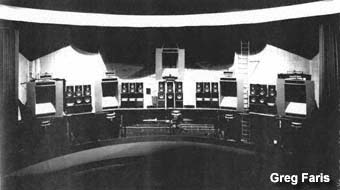Index
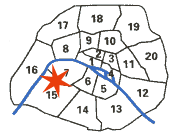 The KinopanoramaTo: the last pictures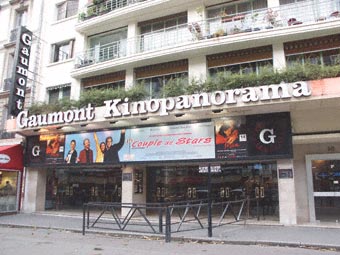 Inaugurated in 1959 at the location of the former "Splendid" in Paris, the Kinopanorama is located on the first floors of an appartment building, built at the same time as the theater. It is the work of a property developer, Pierre Pinton, who would mark his time and several generations of moviegoers... The auditorium is uncommon. Large, but not gigantic, with a balcony, it is equipped for the Kinopanorama, a Russian competitor of the Cinerama (also with an image provided by three different projector), and a very heavy equipment (three couple of projectors...), imported from the USSR. Kinopanorama movies will be played on the very curved 24m screen, starting with "Two Hours In USSR", which will attract 850,000 people in almost two years.
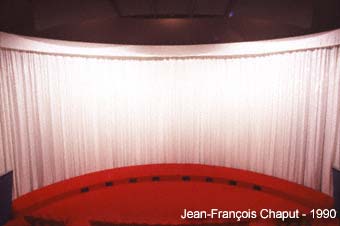
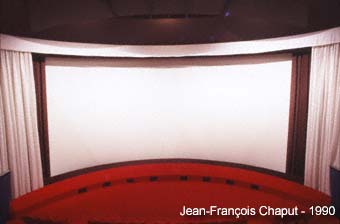
The system will eventually be given up, and the Kinopanorama will play 70mm movies (70mm would become the theater trademark). For a while, the Kinopanorama will be part of the Cinerama theaters in Paris, along with the prestigious Gaumont Palace and Empire, becoming the Cinerama Rive-Gauche, but playing only 70mm prints (no Cinerama). At the end of Cinerama, the Kinopanorama survives, between successes ("Towering Inferno" in 70mm) and problems to get hold of prints. Everything changes in 1979 with the release of "Le Tambour", in 70mm. "Seul à Paris... sur écran géant" (Only in Paris... on giant screen) said the add. This works very well, and the movie will be played for eleven weeks. After that, "The Rose" will be a big success, using several prints during the 48 weeks it will be played on the screen, selling 264,000 tickets. After E.T. (the first movie I saw there), the Kinopanorama will live its happiest times, playing many first run movies in 70mm, among which Revolution, The Mission, The Emerauld Forrest, Legend, The Name Of The Rose, Dune, Year Of The Dragon, Out Of Africa,... The Kinopanorama was then a reference for Parisian moviegoers. It wasn't uncommon then to drive or ride metros or trains for miles, wait in the rain or in the cold for an hour or more, to see movies in the only theater really worth going to, in their own languages, most of the time in 70mm, on its 24m screen (much larger than its competitors'). Its annual box-office grew from 300,00 in 1981 to 450,00 in 1986, the Kinopanorama becoming the second most popular auditorium in Paris after the Grand Rex.
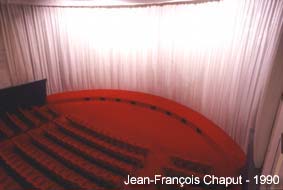
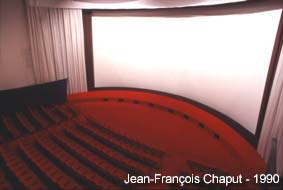
At this time, large screens became popular again; the Forum Horizon opened in Paris in 1986 (with its famous THX auditorium), and the Max Linder was totally remodeled, equipped with a giant screen, THX sound and 70mm, and two balconies; two theaters with a similar number of seats (500 to 600), and screens slightly smaller, will play the same movies as the Kinopanorama (The Last Emperor, The Untouchables, The Bear...), in 70mm; they will quickly become popular, but the Kinopanorama will remain a major theater, often selling 20,000 tickets per week, even though only 303,000 tickets were sold in 1987 (the Kino had been closed for three weeks, and played movies that did less than expected, like The Mosquito Coast, The Witches Of Eastwick, both in 35mm, or Little Shop Of Horrors, this one in 70mm).
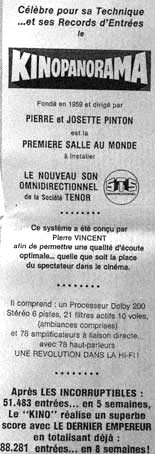 In 1991, the technology race ketp on going, with the installation of the new CDS digital sound system, for the release of "The Doors". In 1992, the Kinopanorama was sold to Gaumont. Among the last movies played in the old Kinopanorama during the first semester, some movies did very well, and others that have been forgotten since: The Lover, The Prince Of Tides, Bugsy, Kafka, Indochine, Howard's End (only 70mm in Paris), and eventually IP5 (Yves Montand's last movie), which was played in Dolby SR sound, whereas the Gaumont Grand Ecran Italie, the Gaumont Ambassade and the Publicis Elysées played in in LC Concept digital sound system. As a symbol, the last movie played at the old Kinopanorama will also be the first one played at its new competitor, the Gaumont Grand Ecran Italie, which attracted huge crowds back then. Five weeks later, the Kinopanorama closed for remodeling on July 15. September 9, the "Gaumont Grand Ecran Grenelle" (!) re-opened ("Grand Ecran" was a label Gaumont had started using for its very large screens like the Gaumont Italie and the Gaumont Rouen). The auditorium looked very nice, all in red, but the screen had been reduced to 17m; the number of seats was also reduced to 500 (the first rows had been removed). A few months later, it was renamed the "Gaumont Kinopanorama". The Gaumont Italie had become Gaumont's main theater.
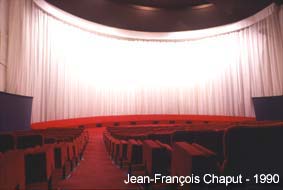
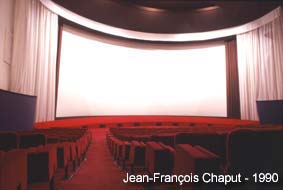
Moviegoers started changing their habbits. The Kinopanorama wasn't the only giant screen in town, and 70mm print became scarce. Other large screens could be found at the Gaumont Italie, the UGC Ciné Cité les Halles and Bercy, and to some extent at the Gaumont Aquaboulevard, Pathé Wepler, and Gaumont Parnasse). The Kinopanorama played movies you could see in other places, with good projection standards you could also find in other places. There was no need to ride miles to the Kino. Eventually, the Kinopanorama was left with its local viewers, except for some recent successes ("Le Peuple Migrateur", Tosca, Star Wars Episode II). Even the director's cut version of "Close Encounters Of The Third Kind" was played in an almost empty auditorium (although it probably wasn't such a good idea to release this after the dvd... At the end of 1998, I had been told that the closing of the Kinopanorama was in the air. After the initial shock, I started hoping that the Kinopanorama would remain a movie theater. I also hoped that the politicians would help, but they didn't seem to care at all. The Kinopanorama seems to be too young to be classified as a monument, even though it is a major part of moviegoing history in Paris. Since the end of 2001, the Kinopanorama almost closed down several times, and June 25 seemed to be the end (even newspapers had relayed the news).
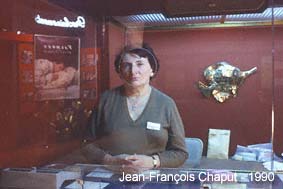
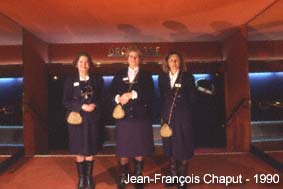
Two pictures of the employees of the Pinton era: left, the cashier behind her window; right, the staff of usherettes July 1, 2002. The Kinopanorama is still there, so is hope...
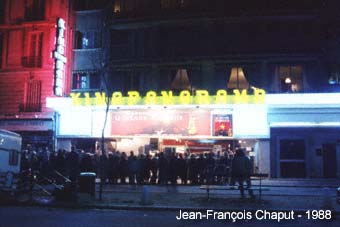
The Kinopanorama - 60, avenue de la Motte-Piquet - 75015 Paris
To: the last pictures
|
